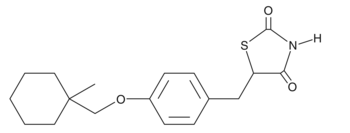Chemicals
Showing 14701–14850 of 41137 results
-
CID797718 is a protein kinase D1 (PKD1) inhibitor (IC50 = 7 µM).{25787} It also inhibits CDK activating kinase (CAK) and polo-like kinase 1 (PLK1) but has no activity at AKT (IC50s = 8.4, 21.9, and >50 µM, respectively). CID797718 inhibits PKD1 activity in LNCaP cells with an IC50 value of 0.21 µM. CID797718 is a byproduct in the synthesis of CID755673 (Item No. 15924).{32618}
Brand:CaymanSKU:23428 - 1 mgAvailable on backorder
CID797718 is a protein kinase D1 (PKD1) inhibitor (IC50 = 7 µM).{25787} It also inhibits CDK activating kinase (CAK) and polo-like kinase 1 (PLK1) but has no activity at AKT (IC50s = 8.4, 21.9, and >50 µM, respectively). CID797718 inhibits PKD1 activity in LNCaP cells with an IC50 value of 0.21 µM. CID797718 is a byproduct in the synthesis of CID755673 (Item No. 15924).{32618}
Brand:CaymanSKU:23428 - 10 mgAvailable on backorder
CID797718 is a protein kinase D1 (PKD1) inhibitor (IC50 = 7 µM).{25787} It also inhibits CDK activating kinase (CAK) and polo-like kinase 1 (PLK1) but has no activity at AKT (IC50s = 8.4, 21.9, and >50 µM, respectively). CID797718 inhibits PKD1 activity in LNCaP cells with an IC50 value of 0.21 µM. CID797718 is a byproduct in the synthesis of CID755673 (Item No. 15924).{32618}
Brand:CaymanSKU:23428 - 25 mgAvailable on backorder
CID797718 is a protein kinase D1 (PKD1) inhibitor (IC50 = 7 µM).{25787} It also inhibits CDK activating kinase (CAK) and polo-like kinase 1 (PLK1) but has no activity at AKT (IC50s = 8.4, 21.9, and >50 µM, respectively). CID797718 inhibits PKD1 activity in LNCaP cells with an IC50 value of 0.21 µM. CID797718 is a byproduct in the synthesis of CID755673 (Item No. 15924).{32618}
Brand:CaymanSKU:23428 - 5 mgAvailable on backorder
Cidofovir is an acyclic nucleoside phosphonate that is active against herpesvirus (including cytomegalovirus (CMV)), polyomavirus, papillomavirus, adenovirus, and poxvirus infections. In vitro, cidofovir is converted to cidofovir diphosphate which incorporates into viral DNA, selectively inhibiting CMV replication and CMV DNA synthesis with IC50 values of 0.1 μM.{22167} Cidofovir has significantly long-lasting antiviral action because of the long half-life of its metabolites whose cellular uptake is slow due to the presence of the negatively charged phosphonate group.{22169} The antiviral efficacy of cidofovir has been demonstrated in numerous experimental animal model infections that mirror all major DNA virus infections in humans.{22168} It has also demonstrated remarkable activity as an antitumor agent in a variety of animal models of tumor growth.{22168}
Brand:CaymanSKU:-Cidofovir is an acyclic nucleoside phosphonate that is active against herpesvirus (including cytomegalovirus (CMV)), polyomavirus, papillomavirus, adenovirus, and poxvirus infections. In vitro, cidofovir is converted to cidofovir diphosphate which incorporates into viral DNA, selectively inhibiting CMV replication and CMV DNA synthesis with IC50 values of 0.1 μM.{22167} Cidofovir has significantly long-lasting antiviral action because of the long half-life of its metabolites whose cellular uptake is slow due to the presence of the negatively charged phosphonate group.{22169} The antiviral efficacy of cidofovir has been demonstrated in numerous experimental animal model infections that mirror all major DNA virus infections in humans.{22168} It has also demonstrated remarkable activity as an antitumor agent in a variety of animal models of tumor growth.{22168}
Brand:CaymanSKU:-Cidofovir is an acyclic nucleoside phosphonate that is active against herpesvirus (including cytomegalovirus (CMV)), polyomavirus, papillomavirus, adenovirus, and poxvirus infections. In vitro, cidofovir is converted to cidofovir diphosphate which incorporates into viral DNA, selectively inhibiting CMV replication and CMV DNA synthesis with IC50 values of 0.1 μM.{22167} Cidofovir has significantly long-lasting antiviral action because of the long half-life of its metabolites whose cellular uptake is slow due to the presence of the negatively charged phosphonate group.{22169} The antiviral efficacy of cidofovir has been demonstrated in numerous experimental animal model infections that mirror all major DNA virus infections in humans.{22168} It has also demonstrated remarkable activity as an antitumor agent in a variety of animal models of tumor growth.{22168}
Brand:CaymanSKU:-Ciglitazone is an antidiabetic drug of the thiazolidinedione structural class. Ciglitazone is a potent and selective PPARγ ligand. It binds to the PPARγ ligand-binding domain with an EC50 of 3.0 µM.{7575} Ciglitazone is active in vivo as an anti-hyperglycemic agent in the ob/ob mouse model.{7575}
Brand:CaymanSKU:71730 - 1 mgAvailable on backorder
Ciglitazone is an antidiabetic drug of the thiazolidinedione structural class. Ciglitazone is a potent and selective PPARγ ligand. It binds to the PPARγ ligand-binding domain with an EC50 of 3.0 µM.{7575} Ciglitazone is active in vivo as an anti-hyperglycemic agent in the ob/ob mouse model.{7575}
Brand:CaymanSKU:71730 - 10 mgAvailable on backorder
Ciglitazone is an antidiabetic drug of the thiazolidinedione structural class. Ciglitazone is a potent and selective PPARγ ligand. It binds to the PPARγ ligand-binding domain with an EC50 of 3.0 µM.{7575} Ciglitazone is active in vivo as an anti-hyperglycemic agent in the ob/ob mouse model.{7575}
Brand:CaymanSKU:71730 - 5 mgAvailable on backorder
Ciglitazone is an antidiabetic drug of the thiazolidinedione structural class. Ciglitazone is a potent and selective PPARγ ligand. It binds to the PPARγ ligand-binding domain with an EC50 of 3.0 µM.{7575} Ciglitazone is active in vivo as an anti-hyperglycemic agent in the ob/ob mouse model.{7575}
Brand:CaymanSKU:71730 - 50 mgAvailable on backorder
CIL56 is a small molecule that induces non-apoptotic cell death in a manner dependent on acetyl-CoA carboxylase 1 (ACC1), the rate-limiting enzyme in fatty acid synthesis.{39187} HT-1080 cells lacking ACC1 exhibit 5-fold resistance to CIL56 treatment, indicating ACC1 activity sensitizes cells to CIL56-induced cell death. CIL56 (6.5 μM) induces accumulation of long-chain saturated, monounsaturated, and polyunsaturated fatty acids in HT-1080 cells in vitro.
Brand:CaymanSKU:-Available on backorder
CIL56 is a small molecule that induces non-apoptotic cell death in a manner dependent on acetyl-CoA carboxylase 1 (ACC1), the rate-limiting enzyme in fatty acid synthesis.{39187} HT-1080 cells lacking ACC1 exhibit 5-fold resistance to CIL56 treatment, indicating ACC1 activity sensitizes cells to CIL56-induced cell death. CIL56 (6.5 μM) induces accumulation of long-chain saturated, monounsaturated, and polyunsaturated fatty acids in HT-1080 cells in vitro.
Brand:CaymanSKU:-Available on backorder
CIL56 is a small molecule that induces non-apoptotic cell death in a manner dependent on acetyl-CoA carboxylase 1 (ACC1), the rate-limiting enzyme in fatty acid synthesis.{39187} HT-1080 cells lacking ACC1 exhibit 5-fold resistance to CIL56 treatment, indicating ACC1 activity sensitizes cells to CIL56-induced cell death. CIL56 (6.5 μM) induces accumulation of long-chain saturated, monounsaturated, and polyunsaturated fatty acids in HT-1080 cells in vitro.
Brand:CaymanSKU:-Available on backorder
CIL56 is a small molecule that induces non-apoptotic cell death in a manner dependent on acetyl-CoA carboxylase 1 (ACC1), the rate-limiting enzyme in fatty acid synthesis.{39187} HT-1080 cells lacking ACC1 exhibit 5-fold resistance to CIL56 treatment, indicating ACC1 activity sensitizes cells to CIL56-induced cell death. CIL56 (6.5 μM) induces accumulation of long-chain saturated, monounsaturated, and polyunsaturated fatty acids in HT-1080 cells in vitro.
Brand:CaymanSKU:-Available on backorder
Cilastatin is an inhibitor of dipeptidase (dehydropeptidase I), a renal dipeptidase.{36366} It inhibits human renal dipeptidase (Ki = 0.7 μM), porcine dipeptidase (IC50 = 0.11 μM), and bacterial metallo-β-lactamase CphA from A. hydrophila (IC50 = 178 μM).{36366,36367,36368} Cilastatin (200 μg/ml) protects primary porcine renal proximal tubular epithelial cells from nephrotoxicity and apoptosis induced by vancomycin (Item No. 15327).{36369} In a mouse model of systemic infection, cilastatin in combination with imipenem (Item No. 16039) protects mice from S. aureus, E. coli, and P. aeruginosa infection.{36370} Cilastatin was designed to inhibit renal metabolism of imipenem and prolong its half-life.{36367} Formulations containing cilastatin in combination with imipenem have been used to treat susceptible bacterial infections.
Brand:CaymanSKU:23511 - 10 mgAvailable on backorder
Cilastatin is an inhibitor of dipeptidase (dehydropeptidase I), a renal dipeptidase.{36366} It inhibits human renal dipeptidase (Ki = 0.7 μM), porcine dipeptidase (IC50 = 0.11 μM), and bacterial metallo-β-lactamase CphA from A. hydrophila (IC50 = 178 μM).{36366,36367,36368} Cilastatin (200 μg/ml) protects primary porcine renal proximal tubular epithelial cells from nephrotoxicity and apoptosis induced by vancomycin (Item No. 15327).{36369} In a mouse model of systemic infection, cilastatin in combination with imipenem (Item No. 16039) protects mice from S. aureus, E. coli, and P. aeruginosa infection.{36370} Cilastatin was designed to inhibit renal metabolism of imipenem and prolong its half-life.{36367} Formulations containing cilastatin in combination with imipenem have been used to treat susceptible bacterial infections.
Brand:CaymanSKU:23511 - 100 mgAvailable on backorder
Cilastatin is an inhibitor of dipeptidase (dehydropeptidase I), a renal dipeptidase.{36366} It inhibits human renal dipeptidase (Ki = 0.7 μM), porcine dipeptidase (IC50 = 0.11 μM), and bacterial metallo-β-lactamase CphA from A. hydrophila (IC50 = 178 μM).{36366,36367,36368} Cilastatin (200 μg/ml) protects primary porcine renal proximal tubular epithelial cells from nephrotoxicity and apoptosis induced by vancomycin (Item No. 15327).{36369} In a mouse model of systemic infection, cilastatin in combination with imipenem (Item No. 16039) protects mice from S. aureus, E. coli, and P. aeruginosa infection.{36370} Cilastatin was designed to inhibit renal metabolism of imipenem and prolong its half-life.{36367} Formulations containing cilastatin in combination with imipenem have been used to treat susceptible bacterial infections.
Brand:CaymanSKU:23511 - 250 mgAvailable on backorder
Cilastatin is an inhibitor of dipeptidase (dehydropeptidase I), a renal dipeptidase.{36366} It inhibits human renal dipeptidase (Ki = 0.7 μM), porcine dipeptidase (IC50 = 0.11 μM), and bacterial metallo-β-lactamase CphA from A. hydrophila (IC50 = 178 μM).{36366,36367,36368} Cilastatin (200 μg/ml) protects primary porcine renal proximal tubular epithelial cells from nephrotoxicity and apoptosis induced by vancomycin (Item No. 15327).{36369} In a mouse model of systemic infection, cilastatin in combination with imipenem (Item No. 16039) protects mice from S. aureus, E. coli, and P. aeruginosa infection.{36370} Cilastatin was designed to inhibit renal metabolism of imipenem and prolong its half-life.{36367} Formulations containing cilastatin in combination with imipenem have been used to treat susceptible bacterial infections.
Brand:CaymanSKU:23511 - 50 mgAvailable on backorder
Cilazapril is a prodrug form of the angiotensin converting enzyme (ACE) inhibitor cilazaprilat.{46686} In vivo, cilazapril (0.1 mg/kg) inhibits plasma ACE activity and inhibits the angiotensin I-induced pressor response in anesthetized rats and cats. It decreases systolic blood pressure in spontaneously hypertensive rats when administered at a dose of 30 mg/kg. Cilazapril (10 mg/kg, p.o.) decreases blood pressure in volume-depleted renal hypertensive dogs. Formulations containing cilazapril have been used in the treatment of hypertension.
Brand:CaymanSKU:29777 - 1 mgAvailable on backorder
Cilazapril is a prodrug form of the angiotensin converting enzyme (ACE) inhibitor cilazaprilat.{46686} In vivo, cilazapril (0.1 mg/kg) inhibits plasma ACE activity and inhibits the angiotensin I-induced pressor response in anesthetized rats and cats. It decreases systolic blood pressure in spontaneously hypertensive rats when administered at a dose of 30 mg/kg. Cilazapril (10 mg/kg, p.o.) decreases blood pressure in volume-depleted renal hypertensive dogs. Formulations containing cilazapril have been used in the treatment of hypertension.
Brand:CaymanSKU:29777 - 10 mgAvailable on backorder
Cilazapril is a prodrug form of the angiotensin converting enzyme (ACE) inhibitor cilazaprilat.{46686} In vivo, cilazapril (0.1 mg/kg) inhibits plasma ACE activity and inhibits the angiotensin I-induced pressor response in anesthetized rats and cats. It decreases systolic blood pressure in spontaneously hypertensive rats when administered at a dose of 30 mg/kg. Cilazapril (10 mg/kg, p.o.) decreases blood pressure in volume-depleted renal hypertensive dogs. Formulations containing cilazapril have been used in the treatment of hypertension.
Brand:CaymanSKU:29777 - 25 mgAvailable on backorder
Cilazapril is a prodrug form of the angiotensin converting enzyme (ACE) inhibitor cilazaprilat.{46686} In vivo, cilazapril (0.1 mg/kg) inhibits plasma ACE activity and inhibits the angiotensin I-induced pressor response in anesthetized rats and cats. It decreases systolic blood pressure in spontaneously hypertensive rats when administered at a dose of 30 mg/kg. Cilazapril (10 mg/kg, p.o.) decreases blood pressure in volume-depleted renal hypertensive dogs. Formulations containing cilazapril have been used in the treatment of hypertension.
Brand:CaymanSKU:29777 - 5 mgAvailable on backorder
Cilengitide is a cyclo-(Arg-Gly-Asp-D-Phe-Val) (cRGDfV) peptide and integrin αVβ3 receptor antagonist.{39378} It inhibits adhesion and induces apoptosis of U87MG and U373MG malignant glioma (MG) cells, but not U251MG cells that lack the integrin αVβ3 receptor, in vitro at a concentration of 20 μg/ml. Cilengitide (200 μg/animal per day) delays tumor implantation time, reduces tumor growth, and prolongs survival in a U87MG mouse model of glioblastoma.{39379} Formulations containing cilengitide are under clinical investigation for the treatment of malignant glioma and melanomas.
Brand:CaymanSKU:22289 -Out of stock
Cilengitide is a cyclo-(Arg-Gly-Asp-D-Phe-Val) (cRGDfV) peptide and integrin αVβ3 receptor antagonist.{39378} It inhibits adhesion and induces apoptosis of U87MG and U373MG malignant glioma (MG) cells, but not U251MG cells that lack the integrin αVβ3 receptor, in vitro at a concentration of 20 μg/ml. Cilengitide (200 μg/animal per day) delays tumor implantation time, reduces tumor growth, and prolongs survival in a U87MG mouse model of glioblastoma.{39379} Formulations containing cilengitide are under clinical investigation for the treatment of malignant glioma and melanomas.
Brand:CaymanSKU:22289 -Out of stock
Cilengitide is a cyclo-(Arg-Gly-Asp-D-Phe-Val) (cRGDfV) peptide and integrin αVβ3 receptor antagonist.{39378} It inhibits adhesion and induces apoptosis of U87MG and U373MG malignant glioma (MG) cells, but not U251MG cells that lack the integrin αVβ3 receptor, in vitro at a concentration of 20 μg/ml. Cilengitide (200 μg/animal per day) delays tumor implantation time, reduces tumor growth, and prolongs survival in a U87MG mouse model of glioblastoma.{39379} Formulations containing cilengitide are under clinical investigation for the treatment of malignant glioma and melanomas.
Brand:CaymanSKU:22289 -Out of stock
Cilengitide is a cyclo-(Arg-Gly-Asp-D-Phe-Val) (cRGDfV) peptide and integrin αVβ3 receptor antagonist.{39378} It inhibits adhesion and induces apoptosis of U87MG and U373MG malignant glioma (MG) cells, but not U251MG cells that lack the integrin αVβ3 receptor, in vitro at a concentration of 20 μg/ml. Cilengitide (200 μg/animal per day) delays tumor implantation time, reduces tumor growth, and prolongs survival in a U87MG mouse model of glioblastoma.{39379} Formulations containing cilengitide are under clinical investigation for the treatment of malignant glioma and melanomas.
Brand:CaymanSKU:22289 -Out of stock
Ciliobrevin A is a hedgehog pathway inhibitor that blocks sonic hedgehog (Shh)-induced hedgehog pathway activation (IC50 = 7 µM).{21061} It disrupts primary cilia formation and inhibits the dynein-dependent microtubial gliding and ATPase activities of the cytoplasmic ATPases associated with various cellular activities (AAA+) family. Ciliobrevin A also inhibits mammalian target of rapamycin complex 1 (mTORC1) activity in uninfected and human cytomegalovirus (HCMV)-infected cells, suggesting that mTORC1 activation requires dynein-dependent transport for cellular activation.{34791}
Brand:CaymanSKU:22587 -Out of stock
Ciliobrevin A is a hedgehog pathway inhibitor that blocks sonic hedgehog (Shh)-induced hedgehog pathway activation (IC50 = 7 µM).{21061} It disrupts primary cilia formation and inhibits the dynein-dependent microtubial gliding and ATPase activities of the cytoplasmic ATPases associated with various cellular activities (AAA+) family. Ciliobrevin A also inhibits mammalian target of rapamycin complex 1 (mTORC1) activity in uninfected and human cytomegalovirus (HCMV)-infected cells, suggesting that mTORC1 activation requires dynein-dependent transport for cellular activation.{34791}
Brand:CaymanSKU:22587 -Out of stock
Ciliobrevin A is a hedgehog pathway inhibitor that blocks sonic hedgehog (Shh)-induced hedgehog pathway activation (IC50 = 7 µM).{21061} It disrupts primary cilia formation and inhibits the dynein-dependent microtubial gliding and ATPase activities of the cytoplasmic ATPases associated with various cellular activities (AAA+) family. Ciliobrevin A also inhibits mammalian target of rapamycin complex 1 (mTORC1) activity in uninfected and human cytomegalovirus (HCMV)-infected cells, suggesting that mTORC1 activation requires dynein-dependent transport for cellular activation.{34791}
Brand:CaymanSKU:22587 -Out of stock
Ciliobrevin A is a hedgehog pathway inhibitor that blocks sonic hedgehog (Shh)-induced hedgehog pathway activation (IC50 = 7 µM).{21061} It disrupts primary cilia formation and inhibits the dynein-dependent microtubial gliding and ATPase activities of the cytoplasmic ATPases associated with various cellular activities (AAA+) family. Ciliobrevin A also inhibits mammalian target of rapamycin complex 1 (mTORC1) activity in uninfected and human cytomegalovirus (HCMV)-infected cells, suggesting that mTORC1 activation requires dynein-dependent transport for cellular activation.{34791}
Brand:CaymanSKU:22587 -Out of stock
Cilnidipine is a dihydropyridine calcium channel blocker that blocks L- and N-type high-voltage-activated calcium currents in rat hippocampal CA1 pyramidal neurons when used at a concentration of 10 μM.{45100} Cilnidipine (3 mg/kg) reduces the pressor response to acute cold stress, as well as mean blood pressure, in spontaneously hypertensive rats.{45101} It dose-dependently reduces mean blood pressure and cerebral vascular resistance without affecting cerebral blood flow in anesthetized rats at doses ranging from 3-100 μg/kg.{45102} Cilnidipine (100 μg/kg, i.p.) reduces cerebral infarction area in a rat model of focal brain ischemia.
Brand:CaymanSKU:26080 - 1 gAvailable on backorder
Cilnidipine is a dihydropyridine calcium channel blocker that blocks L- and N-type high-voltage-activated calcium currents in rat hippocampal CA1 pyramidal neurons when used at a concentration of 10 μM.{45100} Cilnidipine (3 mg/kg) reduces the pressor response to acute cold stress, as well as mean blood pressure, in spontaneously hypertensive rats.{45101} It dose-dependently reduces mean blood pressure and cerebral vascular resistance without affecting cerebral blood flow in anesthetized rats at doses ranging from 3-100 μg/kg.{45102} Cilnidipine (100 μg/kg, i.p.) reduces cerebral infarction area in a rat model of focal brain ischemia.
Brand:CaymanSKU:26080 - 5 gAvailable on backorder
Cilnidipine is a dihydropyridine calcium channel blocker that blocks L- and N-type high-voltage-activated calcium currents in rat hippocampal CA1 pyramidal neurons when used at a concentration of 10 μM.{45100} Cilnidipine (3 mg/kg) reduces the pressor response to acute cold stress, as well as mean blood pressure, in spontaneously hypertensive rats.{45101} It dose-dependently reduces mean blood pressure and cerebral vascular resistance without affecting cerebral blood flow in anesthetized rats at doses ranging from 3-100 μg/kg.{45102} Cilnidipine (100 μg/kg, i.p.) reduces cerebral infarction area in a rat model of focal brain ischemia.
Brand:CaymanSKU:26080 - 500 mgAvailable on backorder
Cilofexor inhibits binding of a synthetic peptide, comprising residues 676-700 of the steroid receptor coactivator 1 (SRC-1), to the farnesoid X receptor (FXR; EC50 = 50 = ≥100 nM).
Brand:CaymanSKU:25747 - 1 mgAvailable on backorder
Cilofexor inhibits binding of a synthetic peptide, comprising residues 676-700 of the steroid receptor coactivator 1 (SRC-1), to the farnesoid X receptor (FXR; EC50 = 50 = ≥100 nM).
Brand:CaymanSKU:25747 - 10 mgAvailable on backorder
Cilofexor inhibits binding of a synthetic peptide, comprising residues 676-700 of the steroid receptor coactivator 1 (SRC-1), to the farnesoid X receptor (FXR; EC50 = 50 = ≥100 nM).
Brand:CaymanSKU:25747 - 25 mgAvailable on backorder
Cilofexor inhibits binding of a synthetic peptide, comprising residues 676-700 of the steroid receptor coactivator 1 (SRC-1), to the farnesoid X receptor (FXR; EC50 = 50 = ≥100 nM).
Brand:CaymanSKU:25747 - 5 mgAvailable on backorder
Cilomilast is a second generation inhibitor of phosphodiesterase 4 (PDE4; IC50 = 0.12 µM for the human enzyme).{49691,49692} It is selective for human PDE4 over bovine PDE1, rat PDE2, and human PDE3 and -5 (IC50s = 74, 65, >100, and 83 µM, respectively).{49691} Cilomilast inhibits LPS-induced production of TNF-α in isolated human monocytes, as well as decreases production of leukotriene B4 (LTB4; Item No. 20110) induced by fMLP (Item No. 21495) in isolated human neutrophils (IC50s = 110 and 40 nM, respectively). It reduces ovalbumin-induced bronchoconstriction and pulmonary eosinophil infiltration in an ovalbumin-sensitized guinea pig model of asthma when administered at doses of 10 and 30 mg/kg.{49691}
Brand:CaymanSKU:25979 - 1 mgAvailable on backorder
Cilomilast is a second generation inhibitor of phosphodiesterase 4 (PDE4; IC50 = 0.12 µM for the human enzyme).{49691,49692} It is selective for human PDE4 over bovine PDE1, rat PDE2, and human PDE3 and -5 (IC50s = 74, 65, >100, and 83 µM, respectively).{49691} Cilomilast inhibits LPS-induced production of TNF-α in isolated human monocytes, as well as decreases production of leukotriene B4 (LTB4; Item No. 20110) induced by fMLP (Item No. 21495) in isolated human neutrophils (IC50s = 110 and 40 nM, respectively). It reduces ovalbumin-induced bronchoconstriction and pulmonary eosinophil infiltration in an ovalbumin-sensitized guinea pig model of asthma when administered at doses of 10 and 30 mg/kg.{49691}
Brand:CaymanSKU:25979 - 10 mgAvailable on backorder
Cilomilast is a second generation inhibitor of phosphodiesterase 4 (PDE4; IC50 = 0.12 µM for the human enzyme).{49691,49692} It is selective for human PDE4 over bovine PDE1, rat PDE2, and human PDE3 and -5 (IC50s = 74, 65, >100, and 83 µM, respectively).{49691} Cilomilast inhibits LPS-induced production of TNF-α in isolated human monocytes, as well as decreases production of leukotriene B4 (LTB4; Item No. 20110) induced by fMLP (Item No. 21495) in isolated human neutrophils (IC50s = 110 and 40 nM, respectively). It reduces ovalbumin-induced bronchoconstriction and pulmonary eosinophil infiltration in an ovalbumin-sensitized guinea pig model of asthma when administered at doses of 10 and 30 mg/kg.{49691}
Brand:CaymanSKU:25979 - 5 mgAvailable on backorder
Cilostamide is a selective inhibitor of phosphodiesterase (PDE)3A and PDE3B with IC50 values of 27 and 50 nM, respectively.{19198} It is less selective for inhibition of PDE1, PDE2, PDE4, PDE5, and PDE7 (IC50s = 12 to > 300 μM).{19198} Cilostamide has been shown to inhibit thrombin-induced platelet aggregation with an IC50 value of 1.1 μM.{19198}
Brand:CaymanSKU:-Cilostamide is a selective inhibitor of phosphodiesterase (PDE)3A and PDE3B with IC50 values of 27 and 50 nM, respectively.{19198} It is less selective for inhibition of PDE1, PDE2, PDE4, PDE5, and PDE7 (IC50s = 12 to > 300 μM).{19198} Cilostamide has been shown to inhibit thrombin-induced platelet aggregation with an IC50 value of 1.1 μM.{19198}
Brand:CaymanSKU:-Cilostamide is a selective inhibitor of phosphodiesterase (PDE)3A and PDE3B with IC50 values of 27 and 50 nM, respectively.{19198} It is less selective for inhibition of PDE1, PDE2, PDE4, PDE5, and PDE7 (IC50s = 12 to > 300 μM).{19198} Cilostamide has been shown to inhibit thrombin-induced platelet aggregation with an IC50 value of 1.1 μM.{19198}
Brand:CaymanSKU:-Cilostazol is a phosphodiesterase 3A (PDE3A) inhibitor (IC50 = 0.2 µM for the platelet enzyme).{54486} It is selective for PDE3A over PDE1, -2, -4, and -5 (IC50s = >5 µM for all). Cilostazol inhibits collagen- or ADP-induced aggregation of isolated rabbit platelets (IC50s = 29 and 31 µM, respectively).{23681} In vivo, cilostazol (30 mg/kg) reduces thrombus formation by 84% in a mouse model of pulmonary thromboembolism. It reduces cardiac fibrosis and prevents the development of diastolic dysfunction and cardiac hypertrophy induced by a high-fat diet and angiotensin II in mice.{54485} Formulations containing cilostazol have been used in the treatment of the symptoms of intermittent claudication in peripheral vascular disease.
Brand:CaymanSKU:-Cilostazol is a phosphodiesterase 3A (PDE3A) inhibitor (IC50 = 0.2 µM for the platelet enzyme).{54486} It is selective for PDE3A over PDE1, -2, -4, and -5 (IC50s = >5 µM for all). Cilostazol inhibits collagen- or ADP-induced aggregation of isolated rabbit platelets (IC50s = 29 and 31 µM, respectively).{23681} In vivo, cilostazol (30 mg/kg) reduces thrombus formation by 84% in a mouse model of pulmonary thromboembolism. It reduces cardiac fibrosis and prevents the development of diastolic dysfunction and cardiac hypertrophy induced by a high-fat diet and angiotensin II in mice.{54485} Formulations containing cilostazol have been used in the treatment of the symptoms of intermittent claudication in peripheral vascular disease.
Brand:CaymanSKU:-Cilostazol is a phosphodiesterase 3A (PDE3A) inhibitor (IC50 = 0.2 µM for the platelet enzyme).{54486} It is selective for PDE3A over PDE1, -2, -4, and -5 (IC50s = >5 µM for all). Cilostazol inhibits collagen- or ADP-induced aggregation of isolated rabbit platelets (IC50s = 29 and 31 µM, respectively).{23681} In vivo, cilostazol (30 mg/kg) reduces thrombus formation by 84% in a mouse model of pulmonary thromboembolism. It reduces cardiac fibrosis and prevents the development of diastolic dysfunction and cardiac hypertrophy induced by a high-fat diet and angiotensin II in mice.{54485} Formulations containing cilostazol have been used in the treatment of the symptoms of intermittent claudication in peripheral vascular disease.
Brand:CaymanSKU:-Cilostazol is a phosphodiesterase 3A (PDE3A) inhibitor (IC50 = 0.2 µM for the platelet enzyme).{54486} It is selective for PDE3A over PDE1, -2, -4, and -5 (IC50s = >5 µM for all). Cilostazol inhibits collagen- or ADP-induced aggregation of isolated rabbit platelets (IC50s = 29 and 31 µM, respectively).{23681} In vivo, cilostazol (30 mg/kg) reduces thrombus formation by 84% in a mouse model of pulmonary thromboembolism. It reduces cardiac fibrosis and prevents the development of diastolic dysfunction and cardiac hypertrophy induced by a high-fat diet and angiotensin II in mice.{54485} Formulations containing cilostazol have been used in the treatment of the symptoms of intermittent claudication in peripheral vascular disease.
Brand:CaymanSKU:-Cilostazol-d4 is intended for use as an internal standard for the quantification of cilostazol (Item No. 15035) by GC- or LC-MS. Cilostazol is a phosphodiesterase 3A (PDE3A) inhibitor (IC50 = 0.2 µM for the platelet enzyme).{54486} It is selective for PDE3A over PDE1, -2, -4, and 5 (IC50s = >5 µM for all). Cilostazol inhibits collagen- or ADP-induced aggregation of isolated rabbit platelets (IC50s = 29 and 31 µM, respectively).{23681} In vivo, cilostazol (30 mg/kg) reduces thrombus formation by 84% in a mouse model of pulmonary thromboembolism. It reduces cardiac fibrosis and prevents the development of diastolic dysfunction and cardiac hypertrophy induced by a high-fat diet and angiotensin II in mice.{54485} Formulations containing cilostazol have been used in the treatment of the symptoms of intermittent claudication in peripheral vascular disease.
Brand:CaymanSKU:31790 - 1 mgAvailable on backorder
CIM0216 is a transient receptor potential melastatin 3 (TRPM3) activator. It induces inward and outward rectifying currents in TRPM3-expressing HEK293 cells voltage-clamped at ±80 mV when used at a concentration of 1 µM.{48910} CIM0216 is selective for TRMP3 over TRPM1, TRPM4, TRPM6, and TRMP7 in HEK293 cells expressing the human channels, but does activate TRPA1 by 15% in CHO cells expressing mouse TRPA1 at 10 µM. CIM0216 also inhibits ADP-ribose-induced TRPM2, calcium-induced TRMP5, and methanol-induced TRPM8 activation by 17, 34, and 61%, respectively, in HEK293 cells expressing the human channels at 10 µM. It stimulates insulin and calcitonin gene-related peptide (CGRP) release in isolated mouse pancreatic islets and skin nerve terminals, respectively, when used at concentrations ranging from 5 to 100 µM.{48910} CIM0216 (20 µM) induces activation of the TRPM3 signal transduction transcription factor AP-1 and its subunits, c-Jun and c-fos, in HEK293 cell reporter assays.{48911}
Brand:CaymanSKU:27684 - 1 mgAvailable on backorder
CIM0216 is a transient receptor potential melastatin 3 (TRPM3) activator. It induces inward and outward rectifying currents in TRPM3-expressing HEK293 cells voltage-clamped at ±80 mV when used at a concentration of 1 µM.{48910} CIM0216 is selective for TRMP3 over TRPM1, TRPM4, TRPM6, and TRMP7 in HEK293 cells expressing the human channels, but does activate TRPA1 by 15% in CHO cells expressing mouse TRPA1 at 10 µM. CIM0216 also inhibits ADP-ribose-induced TRPM2, calcium-induced TRMP5, and methanol-induced TRPM8 activation by 17, 34, and 61%, respectively, in HEK293 cells expressing the human channels at 10 µM. It stimulates insulin and calcitonin gene-related peptide (CGRP) release in isolated mouse pancreatic islets and skin nerve terminals, respectively, when used at concentrations ranging from 5 to 100 µM.{48910} CIM0216 (20 µM) induces activation of the TRPM3 signal transduction transcription factor AP-1 and its subunits, c-Jun and c-fos, in HEK293 cell reporter assays.{48911}
Brand:CaymanSKU:27684 - 10 mgAvailable on backorder
CIM0216 is a transient receptor potential melastatin 3 (TRPM3) activator. It induces inward and outward rectifying currents in TRPM3-expressing HEK293 cells voltage-clamped at ±80 mV when used at a concentration of 1 µM.{48910} CIM0216 is selective for TRMP3 over TRPM1, TRPM4, TRPM6, and TRMP7 in HEK293 cells expressing the human channels, but does activate TRPA1 by 15% in CHO cells expressing mouse TRPA1 at 10 µM. CIM0216 also inhibits ADP-ribose-induced TRPM2, calcium-induced TRMP5, and methanol-induced TRPM8 activation by 17, 34, and 61%, respectively, in HEK293 cells expressing the human channels at 10 µM. It stimulates insulin and calcitonin gene-related peptide (CGRP) release in isolated mouse pancreatic islets and skin nerve terminals, respectively, when used at concentrations ranging from 5 to 100 µM.{48910} CIM0216 (20 µM) induces activation of the TRPM3 signal transduction transcription factor AP-1 and its subunits, c-Jun and c-fos, in HEK293 cell reporter assays.{48911}
Brand:CaymanSKU:27684 - 25 mgAvailable on backorder
CIM0216 is a transient receptor potential melastatin 3 (TRPM3) activator. It induces inward and outward rectifying currents in TRPM3-expressing HEK293 cells voltage-clamped at ±80 mV when used at a concentration of 1 µM.{48910} CIM0216 is selective for TRMP3 over TRPM1, TRPM4, TRPM6, and TRMP7 in HEK293 cells expressing the human channels, but does activate TRPA1 by 15% in CHO cells expressing mouse TRPA1 at 10 µM. CIM0216 also inhibits ADP-ribose-induced TRPM2, calcium-induced TRMP5, and methanol-induced TRPM8 activation by 17, 34, and 61%, respectively, in HEK293 cells expressing the human channels at 10 µM. It stimulates insulin and calcitonin gene-related peptide (CGRP) release in isolated mouse pancreatic islets and skin nerve terminals, respectively, when used at concentrations ranging from 5 to 100 µM.{48910} CIM0216 (20 µM) induces activation of the TRPM3 signal transduction transcription factor AP-1 and its subunits, c-Jun and c-fos, in HEK293 cell reporter assays.{48911}
Brand:CaymanSKU:27684 - 5 mgAvailable on backorder
Cimaterol is a potent agonist of β-adrenergic receptors (pEC50 = 8.13, 8.78, and 6.62 for human β1, β2, and β3, respectively).{25550} Formulations containing cimoterol have been used in farmed animals (swine, fowl, etc.) to increase carcass mass and to alter muscle and fat deposition.{25549,25551}
Brand:CaymanSKU:-Cimaterol is a potent agonist of β-adrenergic receptors (pEC50 = 8.13, 8.78, and 6.62 for human β1, β2, and β3, respectively).{25550} Formulations containing cimoterol have been used in farmed animals (swine, fowl, etc.) to increase carcass mass and to alter muscle and fat deposition.{25549,25551}
Brand:CaymanSKU:-Cimaterol-d7 is intended for use as an internal standard for the quantification of cimaterol (Item No. 15613) by GC- or LC-MS. Cimaterol is a potent agonist of β-adrenergic receptors (pEC50s = 8.13, 8.78, and 6.62 for human β1, β2, and β3, respectively).{25550} Formulations containing cimaterol have been used in farmed animals (swine, fowl, etc.) to increase carcass mass and to alter muscle and fat deposition.{25549,25551}
Brand:CaymanSKU:28903 - 1 mgAvailable on backorder
Cimaterol-d7 is intended for use as an internal standard for the quantification of cimaterol (Item No. 15613) by GC- or LC-MS. Cimaterol is a potent agonist of β-adrenergic receptors (pEC50s = 8.13, 8.78, and 6.62 for human β1, β2, and β3, respectively).{25550} Formulations containing cimaterol have been used in farmed animals (swine, fowl, etc.) to increase carcass mass and to alter muscle and fat deposition.{25549,25551}
Brand:CaymanSKU:28903 - 5 mgAvailable on backorder
Cimaterol-d7 is intended for use as an internal standard for the quantification of cimaterol (Item No. 15613) by GC- or LC-MS. Cimaterol is a potent agonist of β-adrenergic receptors (pEC50s = 8.13, 8.78, and 6.62 for human β1, β2, and β3, respectively).{25550} Formulations containing cimaterol have been used in farmed animals (swine, fowl, etc.) to increase carcass mass and to alter muscle and fat deposition.{25549,25551}
Brand:CaymanSKU:28903 - 500 µgAvailable on backorder
Cimbuterol is an agonist of β-adrenergic receptors (β-ARs).{59215,59216} It has been used as a standard for the simultaneous detection of multiple veterinary residues in commercial animal meat by LC-MS/MS.{59215} Formulations containing cimbuterol have been used to promote growth and improve feed efficiency in livestock.
Brand:CaymanSKU:31743 - 10 mgAvailable on backorder
Cimbuterol is an agonist of β-adrenergic receptors (β-ARs).{59215,59216} It has been used as a standard for the simultaneous detection of multiple veterinary residues in commercial animal meat by LC-MS/MS.{59215} Formulations containing cimbuterol have been used to promote growth and improve feed efficiency in livestock.
Brand:CaymanSKU:31743 - 25 mgAvailable on backorder
Cimbuterol is an agonist of β-adrenergic receptors (β-ARs).{59215,59216} It has been used as a standard for the simultaneous detection of multiple veterinary residues in commercial animal meat by LC-MS/MS.{59215} Formulations containing cimbuterol have been used to promote growth and improve feed efficiency in livestock.
Brand:CaymanSKU:31743 - 5 mgAvailable on backorder
Cimbuterol is an agonist of β-adrenergic receptors (β-ARs).{59215,59216} It has been used as a standard for the simultaneous detection of multiple veterinary residues in commercial animal meat by LC-MS/MS.{59215} Formulations containing cimbuterol have been used to promote growth and improve feed efficiency in livestock.
Brand:CaymanSKU:31743 - 50 mgAvailable on backorder
Cimetidine is a histamine H2 receptor antagonist (Ki = 0.6 μM).{30325} It also acts as an inverse agonist, inhibiting basal cAMP production in CHO cells expressing recombinant H2 receptors (IC50 = 1.2 μM). Cimetidine inhibits histamine-induced acid secretion from isolated bullfrog gastric mucosa (IC50 = 16 μM).{30545} In vivo, it inhibits histamine-induced gastric acid secretion in gastric fistulae and Heidenhain pouches in dogs (ED50 = 1.88 μmol/kg, p.o.). Cimetidine (20 mg/kg per day) also reduces tumor growth and neovascularization in a CMT93 colon cancer mouse syngeneic model.{47643}
Brand:CaymanSKU:-Available on backorder
Cimetidine is a histamine H2 receptor antagonist (Ki = 0.6 μM).{30325} It also acts as an inverse agonist, inhibiting basal cAMP production in CHO cells expressing recombinant H2 receptors (IC50 = 1.2 μM). Cimetidine inhibits histamine-induced acid secretion from isolated bullfrog gastric mucosa (IC50 = 16 μM).{30545} In vivo, it inhibits histamine-induced gastric acid secretion in gastric fistulae and Heidenhain pouches in dogs (ED50 = 1.88 μmol/kg, p.o.). Cimetidine (20 mg/kg per day) also reduces tumor growth and neovascularization in a CMT93 colon cancer mouse syngeneic model.{47643}
Brand:CaymanSKU:-Available on backorder
Cimetidine is a histamine H2 receptor antagonist (Ki = 0.6 μM).{30325} It also acts as an inverse agonist, inhibiting basal cAMP production in CHO cells expressing recombinant H2 receptors (IC50 = 1.2 μM). Cimetidine inhibits histamine-induced acid secretion from isolated bullfrog gastric mucosa (IC50 = 16 μM).{30545} In vivo, it inhibits histamine-induced gastric acid secretion in gastric fistulae and Heidenhain pouches in dogs (ED50 = 1.88 μmol/kg, p.o.). Cimetidine (20 mg/kg per day) also reduces tumor growth and neovascularization in a CMT93 colon cancer mouse syngeneic model.{47643}
Brand:CaymanSKU:-Available on backorder
Cimetidine is a histamine H2 receptor antagonist (Ki = 0.6 μM).{30325} It also acts as an inverse agonist, inhibiting basal cAMP production in CHO cells expressing recombinant H2 receptors (IC50 = 1.2 μM). Cimetidine inhibits histamine-induced acid secretion from isolated bullfrog gastric mucosa (IC50 = 16 μM).{30545} In vivo, it inhibits histamine-induced gastric acid secretion in gastric fistulae and Heidenhain pouches in dogs (ED50 = 1.88 μmol/kg, p.o.). Cimetidine (20 mg/kg per day) also reduces tumor growth and neovascularization in a CMT93 colon cancer mouse syngeneic model.{47643}
Brand:CaymanSKU:-Available on backorder
Cimetidine-d3 is intended for use as an internal standard for the quantification of cimetidine (Item No. 18743) by GC- or LC-MS. Cimetidine is a histamine H2 receptor antagonist (Ki = 0.6 μM).{30325} It also acts as an inverse agonist, inhibiting basal cAMP production in CHO cells expressing recombinant H2 receptors (IC50 = 1.2 μM). Cimetidine inhibits histamine-induced acid secretion from isolated bullfrog gastric mucosa (IC50 = 16 μM).{30545} In vivo, it inhibits histamine-induced gastric acid secretion in gastric fistulae and Heidenhain pouches in dogs (ED50 = 1.88 μmol/kg, p.o.). Cimetidine (20 mg/kg per day) also reduces tumor growth and neovascularization in a CMT93 colon cancer mouse syngeneic model.{47643}
Brand:CaymanSKU:29050 - 1 mgAvailable on backorder
Cimicoxib is a non-steroidal anti-inflammatory drug (NSAID) that inhibits COX-2 selectively over COX-1 (IC50s = 0.005 and 3.3 μM, respectively). {47333,11434} It inhibits paw swelling by 93% in a rat model of adjuvant-induced arthritis when administered at a dose of 1 mg/kg.{11434} Cimicoxib (3 mg/kg, p.o.) inhibits carrageenan-induced decreases in paw withdrawal latency in the hot plate test in a rat model of hyperalgesia. Formulations containing cimicoxib have been used in the treatment of pain and inflammation associated with osteoarthritis or surgery in dogs.
Brand:CaymanSKU:10006295 - 1 mgAvailable on backorder
Cimicoxib is a non-steroidal anti-inflammatory drug (NSAID) that inhibits COX-2 selectively over COX-1 (IC50s = 0.005 and 3.3 μM, respectively). {47333,11434} It inhibits paw swelling by 93% in a rat model of adjuvant-induced arthritis when administered at a dose of 1 mg/kg.{11434} Cimicoxib (3 mg/kg, p.o.) inhibits carrageenan-induced decreases in paw withdrawal latency in the hot plate test in a rat model of hyperalgesia. Formulations containing cimicoxib have been used in the treatment of pain and inflammation associated with osteoarthritis or surgery in dogs.
Brand:CaymanSKU:10006295 - 10 mgAvailable on backorder
Cimicoxib is a non-steroidal anti-inflammatory drug (NSAID) that inhibits COX-2 selectively over COX-1 (IC50s = 0.005 and 3.3 μM, respectively). {47333,11434} It inhibits paw swelling by 93% in a rat model of adjuvant-induced arthritis when administered at a dose of 1 mg/kg.{11434} Cimicoxib (3 mg/kg, p.o.) inhibits carrageenan-induced decreases in paw withdrawal latency in the hot plate test in a rat model of hyperalgesia. Formulations containing cimicoxib have been used in the treatment of pain and inflammation associated with osteoarthritis or surgery in dogs.
Brand:CaymanSKU:10006295 - 5 mgAvailable on backorder
Cinacalcet is a calcimimetic and an allosteric agonist of the calcium-sensing receptor (CaSR; EC50 = 79.4 nM in HEK293T cells expressing the human receptor).{26279} In vivo, cinacalcet (0.1-10 mg/kg, s.c.) decreases plasma levels of parathyroid hormone (PTH) in rats. It also decreases plasma levels of PTH and parathyroid cell proliferation in a mouse model of primary hyperparathyroidism.{39827} Formulations containing cinacalcet have been used in the treatment of secondary hyperparathyroidism due to end-stage renal disease and hypercalcemia in patients with parathyroid carcinoma.
Brand:CaymanSKU:-Cinacalcet is a calcimimetic and an allosteric agonist of the calcium-sensing receptor (CaSR; EC50 = 79.4 nM in HEK293T cells expressing the human receptor).{26279} In vivo, cinacalcet (0.1-10 mg/kg, s.c.) decreases plasma levels of parathyroid hormone (PTH) in rats. It also decreases plasma levels of PTH and parathyroid cell proliferation in a mouse model of primary hyperparathyroidism.{39827} Formulations containing cinacalcet have been used in the treatment of secondary hyperparathyroidism due to end-stage renal disease and hypercalcemia in patients with parathyroid carcinoma.
Brand:CaymanSKU:-Cinacalcet is a calcimimetic and an allosteric agonist of the calcium-sensing receptor (CaSR; EC50 = 79.4 nM in HEK293T cells expressing the human receptor).{26279} In vivo, cinacalcet (0.1-10 mg/kg, s.c.) decreases plasma levels of parathyroid hormone (PTH) in rats. It also decreases plasma levels of PTH and parathyroid cell proliferation in a mouse model of primary hyperparathyroidism.{39827} Formulations containing cinacalcet have been used in the treatment of secondary hyperparathyroidism due to end-stage renal disease and hypercalcemia in patients with parathyroid carcinoma.
Brand:CaymanSKU:-Cinacalcet is a calcimimetic and an allosteric agonist of the calcium-sensing receptor (CaSR; EC50 = 79.4 nM in HEK293T cells expressing the human receptor).{26279} In vivo, cinacalcet (0.1-10 mg/kg, s.c.) decreases plasma levels of parathyroid hormone (PTH) in rats. It also decreases plasma levels of PTH and parathyroid cell proliferation in a mouse model of primary hyperparathyroidism.{39827} Formulations containing cinacalcet have been used in the treatment of secondary hyperparathyroidism due to end-stage renal disease and hypercalcemia in patients with parathyroid carcinoma.
Brand:CaymanSKU:-Soluble guanylate cyclase (sGC) is the primary cellular receptor for NO. NO binds and activates a heme group in sGC, initiating the conversion of GTP to the second messenger cGMP. cGMP subsequently mediates a number of signaling cascades leading to vasorelaxation and inhibiting smooth muscle proliferation, leukocyte recruitment, and platelet aggregation. Oxidation of the heme results in its dissociation from sGC and an impairment of NO signaling, which has been linked to hypertension, hyperlidemia, cardiovascular disease, and diabetes.{26751} Cinaciguat is an activator of sGC that binds to a regulatory site, resulting in activation in an NO-independent manner (Kd = 3.2 nM).{29430} It activates the enzyme even if it has been oxidized or rendered heme deficient.{29430} In animals, cinaciguat has been shown to reduce hypertension, limit cardiomyocyte hypertrophy, protect against ischemia/reperfusion injury, and reduce morbidity and mortality in response to endotoxic shock.{29430,29428,29429,29431}
Brand:CaymanSKU:-Available on backorder
Soluble guanylate cyclase (sGC) is the primary cellular receptor for NO. NO binds and activates a heme group in sGC, initiating the conversion of GTP to the second messenger cGMP. cGMP subsequently mediates a number of signaling cascades leading to vasorelaxation and inhibiting smooth muscle proliferation, leukocyte recruitment, and platelet aggregation. Oxidation of the heme results in its dissociation from sGC and an impairment of NO signaling, which has been linked to hypertension, hyperlidemia, cardiovascular disease, and diabetes.{26751} Cinaciguat is an activator of sGC that binds to a regulatory site, resulting in activation in an NO-independent manner (Kd = 3.2 nM).{29430} It activates the enzyme even if it has been oxidized or rendered heme deficient.{29430} In animals, cinaciguat has been shown to reduce hypertension, limit cardiomyocyte hypertrophy, protect against ischemia/reperfusion injury, and reduce morbidity and mortality in response to endotoxic shock.{29430,29428,29429,29431}
Brand:CaymanSKU:-Available on backorder
Soluble guanylate cyclase (sGC) is the primary cellular receptor for NO. NO binds and activates a heme group in sGC, initiating the conversion of GTP to the second messenger cGMP. cGMP subsequently mediates a number of signaling cascades leading to vasorelaxation and inhibiting smooth muscle proliferation, leukocyte recruitment, and platelet aggregation. Oxidation of the heme results in its dissociation from sGC and an impairment of NO signaling, which has been linked to hypertension, hyperlidemia, cardiovascular disease, and diabetes.{26751} Cinaciguat is an activator of sGC that binds to a regulatory site, resulting in activation in an NO-independent manner (Kd = 3.2 nM).{29430} It activates the enzyme even if it has been oxidized or rendered heme deficient.{29430} In animals, cinaciguat has been shown to reduce hypertension, limit cardiomyocyte hypertrophy, protect against ischemia/reperfusion injury, and reduce morbidity and mortality in response to endotoxic shock.{29430,29428,29429,29431}
Brand:CaymanSKU:-Available on backorder
Soluble guanylate cyclase (sGC) is the primary cellular receptor for NO. NO binds and activates a heme group in sGC, initiating the conversion of GTP to the second messenger cGMP. cGMP subsequently mediates a number of signaling cascades leading to vasorelaxation and inhibiting smooth muscle proliferation, leukocyte recruitment, and platelet aggregation. Oxidation of the heme results in its dissociation from sGC and an impairment of NO signaling, which has been linked to hypertension, hyperlidemia, cardiovascular disease, and diabetes.{26751} Cinaciguat is an activator of sGC that binds to a regulatory site, resulting in activation in an NO-independent manner (Kd = 3.2 nM).{29430} It activates the enzyme even if it has been oxidized or rendered heme deficient.{29430} In animals, cinaciguat has been shown to reduce hypertension, limit cardiomyocyte hypertrophy, protect against ischemia/reperfusion injury, and reduce morbidity and mortality in response to endotoxic shock.{29430,29428,29429,29431}
Brand:CaymanSKU:-Available on backorder
Cinanserin is a serotonin (5-HT) receptor antagonist.{61112,61113} It inhibits 5-HT-induced effects on isolated rat uterus but not guinea pig ileum.{61112} Cinanserin inhibits 5-HT-induced gross excitation, gastric mucosal erosion, and anaphylactoid edema in mice and rats. Cinanserin (12 and 36 mg/kg, i.p.) impairs acquisition of a running response in rats trained for food reward.{61113} It inhibits severe acute respiratory syndrome coronavirus (SARS-CoV) 3C-like proteinase (3CLPro; IC50 = 5 µM) and reduces SARS-CoV viral RNA levels in infected BHK-Rep-1 cells (IC50s = 19-34 µM).{61114} It also inhibits viral replication of murine hepatitis virus (MHV) in CCL-9.1 murine liver epithelial cells (IC50 = 31.25 µg/ml).{32157}
Brand:CaymanSKU:30729 - 10 mgAvailable on backorder
Cinanserin is a serotonin (5-HT) receptor antagonist.{61112,61113} It inhibits 5-HT-induced effects on isolated rat uterus but not guinea pig ileum.{61112} Cinanserin inhibits 5-HT-induced gross excitation, gastric mucosal erosion, and anaphylactoid edema in mice and rats. Cinanserin (12 and 36 mg/kg, i.p.) impairs acquisition of a running response in rats trained for food reward.{61113} It inhibits severe acute respiratory syndrome coronavirus (SARS-CoV) 3C-like proteinase (3CLPro; IC50 = 5 µM) and reduces SARS-CoV viral RNA levels in infected BHK-Rep-1 cells (IC50s = 19-34 µM).{61114} It also inhibits viral replication of murine hepatitis virus (MHV) in CCL-9.1 murine liver epithelial cells (IC50 = 31.25 µg/ml).{32157}
Brand:CaymanSKU:30729 - 5 mgAvailable on backorder
Cinazepam (Item No. 30208) is an analytical reference standard categorized as a benzodiazepine.{52356} Cinazepam is a prodrug form of 3-hydroxy phenazepam (Item No. 11472) that has anxiolytic and sedative properties. This product is intended for research and forensic applications.
Brand:CaymanSKU:30208 - 1 mgAvailable on backorder
























